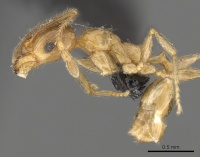Pheidole capensis
| Pheidole capensis | |
|---|---|

| |
| Scientific classification | |
| Kingdom: | Animalia |
| Phylum: | Arthropoda |
| Class: | Insecta |
| Order: | Hymenoptera |
| Family: | Formicidae |
| Subfamily: | Myrmicinae |
| Tribe: | Attini |
| Genus: | Pheidole |
| Species: | P. capensis |
| Binomial name | |
| Pheidole capensis Mayr, 1862 | |
| Subspecies | |
| |
Identification
Distribution
Latitudinal Distribution Pattern
Latitudinal Range: -29.11667° to -34.76667°.
| North Temperate |
North Subtropical |
Tropical | South Subtropical |
South Temperate |
- Source: AntMaps
Distribution based on Regional Taxon Lists
Afrotropical Region: Mozambique, South Africa (type locality).
Distribution based on AntMaps
Distribution based on AntWeb specimens
Check data from AntWeb
Countries Occupied
| Number of countries occupied by this species based on AntWiki Regional Taxon Lists. In general, fewer countries occupied indicates a narrower range, while more countries indicates a more widespread species. |

|
Estimated Abundance
| Relative abundance based on number of AntMaps records per species (this species within the purple bar). Fewer records (to the left) indicates a less abundant/encountered species while more records (to the right) indicates more abundant/encountered species. |

|
Biology
Association with Other Organisms
 Explore: Show all Associate data or Search these data. See also a list of all data tables or learn how data is managed.
Explore: Show all Associate data or Search these data. See also a list of all data tables or learn how data is managed.
This species is a host for the eucharitid wasp Timioderus acuminatus (a parasite) (Heraty, 2000; Baker et al., 2019; Universal Chalcidoidea Database) (primary host).
Castes
Images from AntWeb
   
| |
| Syntype of Pheidole capensis. Worker (major/soldier). Specimen code casent0901307. Photographer Ryan Perry, uploaded by California Academy of Sciences. | Owned by NHMUK, London, UK. |
Nomenclature
The following information is derived from Barry Bolton's Online Catalogue of the Ants of the World.
- capensis. Pheidole capensis Mayr, 1862: 746 (s.w.) SOUTH AFRICA. Forel, 1913a: 130 (q.). Subspecies of megacephala: Emery, 1895h: 34. Revived status as species: Forel, 1913a: 130; Arnold, 1920a: 441. Current subspecies: nominal plus dregei, modestior, reddenburgensis.
Description
References
- Arnold, G. 1920a. A monograph of the Formicidae of South Africa. Part IV. Myrmicinae. Ann. S. Afr. Mus. 14: 403-578 (page 441, revived status as species)
- Baker, A.J., Heraty, J.M., Mottern, J., Hang, J.Z., Hines, H.M., Lemmon, A.R., Lemmon, E.M. 2019. Inverse dispersal patterns in a group of ant parasitoids (Hymenoptera: Eucharitidae: Oraseminae) and their ant hosts. Systematic Entomology 45: 1–19 (doi:10.1111/syen.12371).
- Devenish, A.J.M., Newton, R.J., Bridle, J.R., Gomez, C., Midgley, J.J., Sumner, S. 2021. Contrasting responses of native ant communities to invasion by an ant invader, Linepithema humile. Biological Invasions 23, 2553–2571 (doi:10.1007/s10530-021-02522-7).
- Emery, C. 1895i. Voyage de M. E. Simon dans l'Afrique australe (janvier-avril 1893). 3e mémoire. Formicides. Ann. Soc. Entomol. Fr. 64: 15-56 (page 34, subspecies of megacephala)
- Forel, A. 1913a. Fourmis de Rhodesia, etc. récoltées par M. G. Arnold, le Dr. H. Brauns et K. Fikendey. Ann. Soc. Entomol. Belg. 57: 108-147 (page 130, queen described)
- Forel, A. 1913a. Fourmis de Rhodesia, etc. récoltées par M. G. Arnold, le Dr. H. Brauns et K. Fikendey. Ann. Soc. Entomol. Belg. 57: 108-147 (page 130, revived status as species)
- Mayr, G. 1862. Myrmecologische Studien. Verh. K-K. Zool.-Bot. Ges. Wien 12: 649-776 (page 746, soldier, worker described)
- Witt, A.B.R., Giliomee, J.H. 2005. Dispersal of elaiosome-bearing seeds of six plant species by native species of ants and the introduced invasive ant, Linepithema humile (Mayr) (Hymenoptera: Formicidae) in the Western Cape Province, South Africa. African Plant Protection 11, 1-7.
References based on Global Ant Biodiversity Informatics
- Arnold G. 1920. A monograph of the Formicidae of South Africa. Part IV. Myrmicinae. Annals of the South African Museum. 14: 403-578.
- Emery C. 1895. Voyage de M. E. Simon dans l'Afrique australe (janvier-avril 1893). 3e mémoire. Formicides. Annales de la Société Entomologique de France 64: 15-56.
- French K., and R. E. Major. 2001. Effect of an exotic Acacia (Fabaceae) on ant assemblages in South African fynbos. Austral Ecology 26: 303310.
- IZIKO South Africa Museum Collection
- Wheeler W. M. 1922. Ants of the American Museum Congo expedition. A contribution to the myrmecology of Africa. VIII. A synonymic list of the ants of the Ethiopian region. Bulletin of the American Museum of Natural History 45: 711-1004

